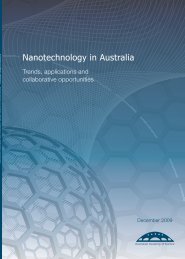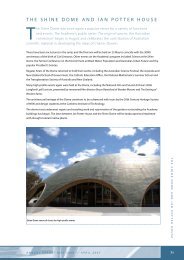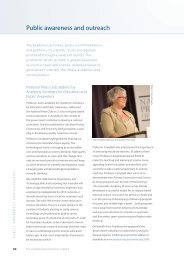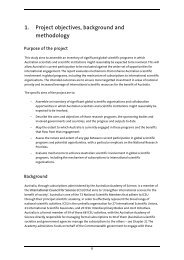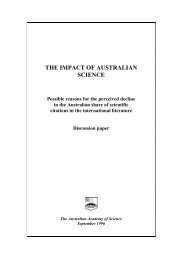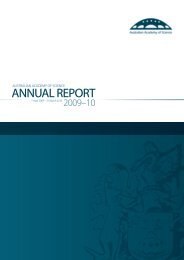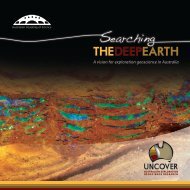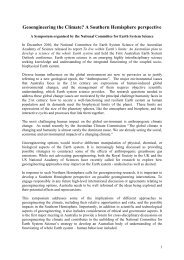Australia's Major National Research Facilities - Australian Academy ...
Australia's Major National Research Facilities - Australian Academy ...
Australia's Major National Research Facilities - Australian Academy ...
You also want an ePaper? Increase the reach of your titles
YUMPU automatically turns print PDFs into web optimized ePapers that Google loves.
Nor is it appropriate to discuss the level of staffing involved in running it, as staffing will be different on the replacement reactor due to<br />
substantially different operation requirements.<br />
The Bragg Institute at ANSTO—which undertakes neutron scattering and instrument development as well as providing services to<br />
researchers from other organisations—currently has 24 scientific staff, eight scientific operations staff and six staff in its technical<br />
support group. (See www.ansto.gov.au/ansto/bragg/staff/staff.html for a full staff list.) . HIFAR is due to close in 2006.<br />
Replacement Reactor<br />
HIFAR is being replaced by a 20 megawatt pool reactor that uses low enriched uranium fuel and is cooled by water. It will be a<br />
multipurpose facility for radioisotope production, irradiation services and neutron beam research. Its compact core is designed to<br />
achieve high performance in the production of neutrons. It is due to be fully operational in 2006.<br />
Its neutron beams will be many times more effective than HIFAR’s as they will be more intense and substantially free of gamma<br />
radiation. Unlike HIFAR, the replacement reactor will also produce cold neutron beams which will allow scientists to conduct research<br />
into the structure of biological matter, which was not previously possible. This opens up more scientific research avenues.<br />
Eight neutron beam instruments are planned for the reactor when it goes critical. Seven of the eight will be among the top such<br />
instruments in the world. ANSTO expects to add more instruments within five years. The facility has the capacity for further<br />
expansion, including potential for a second neutron guide hall. A suite of ancillary equipment will enable studies at different<br />
temperatures, pressures and magnetic field. (For more information see www.ansto.gov.au/ansto/bragg/2005/nsrrr.html.)<br />
The replacement reactor will cost $330 million. The Minister for Education, Science and Training, Dr Brendan Nelson, will announce<br />
the official name of the replacement reactor on 24 January 2005.<br />
Taking into account the fact there are three shifts a day, the total operating organisation will average around 70 people. This covers the<br />
range of applications, not only research. This number does not include Bragg Institute staff (see above) and visiting scientists.<br />
In the 2004-05 budget, the <strong>Australian</strong> Government allocated funding of $7.4 million over four years to ANSTO for scientific staff to<br />
exploit the greatly increased neutron beamline capacity of the replacement reactor. This will enable ANSTO to provide maximum<br />
support for research at the reactor.<br />
Relationship to synchrotrons<br />
The production of high intensities of neutrons in research reactors complements the use of synchrotrons that produce very high<br />
intensities of electromagnetic radiation (in the form of x-rays, ultraviolet light and infra-red light). Neutron scattering penetrates<br />
deeper than x-rays, and can be used, for instance, to look inside a pressure device or deep into a weld, or to map the stresses in a<br />
casting. Neutron scattering can reveal processes deep inside thick containers or large objects.<br />
ANSTO - Tandem accelerators<br />
ANTARES<br />
The <strong>Australian</strong> <strong>National</strong> Tandem Accelerator for Applied <strong>Research</strong> (ANTARES) is a 10 million volt FN-type nuclear tandem<br />
accelerator purchased from a US university in 1990 and completely refurbished and upgraded at ANSTO.<br />
It provides ultra-sensitive radioisotope and isotopic abundance analyses for tracing and dating in the fields of environmental and earth<br />
sciences (e.g. atmospheric research, oceanography, archaeology and heritage, Quaternary science and modern climate change),<br />
characterisation of new materials, bio-medicine and nuclear safeguards.<br />
26



